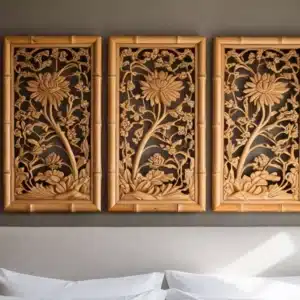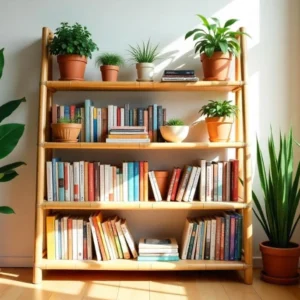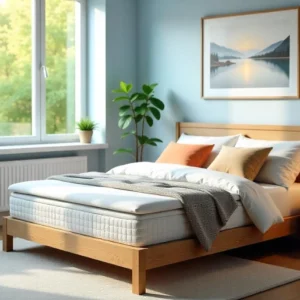Just like other design areas, interior design is closely connected to changing styles – what’s trendy and what’s not.
No matter if the main design aim is decoration, renovation, or architectural detailing, all interior designers must keep up with the latest trends in the field.
One of the fastest-growing segments in the design industry is the integration of sustainable or “green” interior design. This means using eco-friendly practices, like collecting rainwater to support water needs, and opting for sustainable materials such as bamboo. There’s a lot of innovation happening in creating sustainable spaces for a greener future.
What is Sustainable Architecture?
Sustainable architecture is a special kind of building design that focuses on helping the environment and the world we live in. It tries to create structures that are friendly to nature and use resources wisely. The goal is to minimise negative impacts on the planet.
In sustainable architecture, many important things are considered. One is the choice of materials. Builders try to use materials that can be renewed or recycled. They also want to make sure the materials are not harmful to people’s health or the environment.
Energy is another big concern in sustainable architecture. Designers try to use energy-efficient techniques and technology to reduce the amount of energy buildings need. This can include using natural light and ventilation or using renewable energy sources like solar power.
Sustainable architecture also thinks about how buildings interact with their surroundings. It tries to fit into the landscape without harming it. Sometimes, architects use techniques to collect rainwater or help with cooling and heating.
How Sustainable Architecture Helps in a Green Future?

Sustainable architecture is like building stuff in a way that helps nature and the planet. It’s like being friendly to the environment and making sure we use resources wisely. This kind of architecture can play a big role in making a green future, you know?
One way it helps is by saving energy. Sustainable buildings are designed to use less power for heating, cooling, and lighting. They might use energy-efficient materials and have good insulation to keep the inside comfortable without wasting energy.
Another cool thing is using renewable energy sources. Some sustainable buildings have solar panels on their roofs to capture the sun’s energy and turn it into electricity. It’s like using the sun’s power to run the building, which is super eco-friendly.
Recycling is important too! Sustainable architecture promotes using recycled materials for construction. Instead of chopping down new trees, we can use reclaimed wood or other recycled materials to build structures. This reduces waste and keeps things green.
Water is precious, and sustainable architecture knows that. Some buildings collect rainwater and use it for things like watering plants or flushing toilets. This way, we don’t waste clean water and help in conservation.
Also, green spaces! Sustainable architecture often includes gardens or green roofs. These green areas help with air quality, provide habitats for animals, and make the place more beautiful. Plus, they can help reduce the “heat island” effect in cities, making it cooler and nicer for everyone.
Overall, sustainable architecture is about designing buildings that are kind to the environment and work with nature, not against it. By doing this, we can make our future greener and more sustainable for generations to come.
Designing Home with Sustainable Architecture

When designing a sustainable home, think about using renewable resources like solar panels to harness the power of the sun for electricity. This way, you can reduce your reliance on fossil fuels, which are not good for the planet. You can also consider using energy-efficient appliances that consume less electricity and save you money in the long run.
Another important aspect is the construction materials. Choose materials that are environmentally friendly and have less negative impact on the earth. For example, you could go for recycled or reclaimed wood instead of cutting down new trees. Additionally, you can use materials that have a low carbon footprint, meaning they don’t produce a lot of harmful gases when they’re made.
Making your home more energy-efficient can also involve insulating it properly to keep the heat inside during colder months and prevent it from escaping. This way, you won’t need to use as much heating, which saves energy and reduces your carbon footprint.
It’s also a great idea to design your home in a way that takes advantage of natural light and ventilation. This means having big windows and using airflow to keep the house cool without relying too much on air conditioning.
When it comes to the landscape, you can create a sustainable garden with native plants that don’t need a lot of water to thrive. This reduces the need for excessive watering and helps preserve water resources.
Designer Tips
Here are some simple tips for sustainable architecture:
Use eco-friendly materials: When designing a sustainable building, try to use materials that are environmentally friendly and have a lower impact on the planet. Consider options like recycled materials, natural fibres, and locally sourced products.
Energy-efficient design: Optimise the building’s design to make the most of natural light and ventilation. This can help reduce the need for artificial lighting and air conditioning, lowering energy consumption.
Insulation: Proper insulation can help maintain a comfortable indoor temperature and reduce the need for heating or cooling systems, thus saving energy.
Water conservation: Incorporate water-saving fixtures like low-flow toilets and faucets. Harvesting rainwater for non-potable uses can also be beneficial.
Renewable energy sources: If possible, integrate renewable energy sources such as solar panels or wind turbines to generate electricity for the building.
Green spaces: Include greenery and vegetation around the building to enhance air quality, provide shade, and promote a more sustainable urban environment.
Adaptive reuse: Consider renovating and repurposing existing structures rather than demolishing them. This helps preserve resources and reduces construction waste.
Recycle and manage waste: Implement a waste management plan during construction and encourage recycling throughout the building’s life cycle.
Life Cycle analysis: Think about the long-term impact of the building and its materials. Aim for designs that have a low environmental footprint over their entire lifespan.
Community engagement: Involve the community in the design process to understand their needs and preferences, ensuring that the building serves the people and the environment better.
Remember, sustainable architecture is about finding a balance between functionality, aesthetics, and environmental responsibility.





